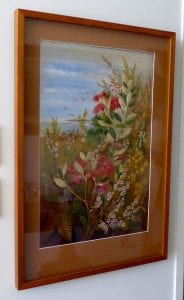The bouquet of white mānuka and pōhutukawa blends into a landscape, ocean in the distance, a blue sky with wisps of cloud and gulls flying. A context is being suggested but not a straight-forward one. We are looking at a bouquet and yet these fronds and stems of flowers stand in for the trees in the landscape. Emily Harris has her botanical eye on the flowers and her artist’s eye on a composition that shows us detail and context in the same frame.
 The painting is signed ‘E.C. Harris 1906.’ It is large (810 x 520mm), oil on straw board that has at some time become bowed and now floats in a specially designed frame behind glass after restoration at the Auckland Art Gallery in 2006. The painting is one of three Emily Harris flower studies hanging in the home of Annabel Galpin, who is a great-great niece of Emily.
The painting is signed ‘E.C. Harris 1906.’ It is large (810 x 520mm), oil on straw board that has at some time become bowed and now floats in a specially designed frame behind glass after restoration at the Auckland Art Gallery in 2006. The painting is one of three Emily Harris flower studies hanging in the home of Annabel Galpin, who is a great-great niece of Emily.
And 1906? In that year Emily Harris sent 12 works to the New Zealand International Exhibition in Christchurch, all of them studies of New Zealand flora. From the description in a Nelson paper, it seems likely that Annabel’s painting was one of the 12: ’A great many varieties have been most artistically grouped together, in some cases the surroundings and conditions under which the flowers grow being depicted in the background. Two panels of Antarctic flowers have also been painted by Miss Harris, and these will be hung in the art gallery.’
The panels that went to Christchurch are now at Puke Ariki Museum in New Plymouth. They are oil paintings on board. One is titled ‘Flowers from the Antarctic Islands of New Zealand’ (1037 x 617mm). The other shows a spray of clematis in flower with background fern fronds, Tmesipteris and toitoi flowers (1455 x 685mm). Emily priced each at 10 guineas. With three of her paintings for Christchurch 1906 now coming into view, we might begin to see how Emily Harris put her ideas about form and composition into practice on a scale not seen in her earlier works.
Lead writer: Michele Leggott
Research support: Makyla Curtis, Betty Davis